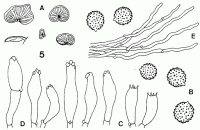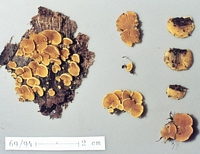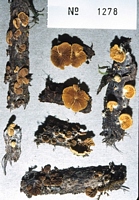|
 Crepidotus parietalis Crepidotus parietalis
BiostatusPresent in region - Indigenous. Non endemic
Images (click to enlarge)
Caption: Crepidotus parietalis Horak (type); A. carpophores. — B. spores. — C. basidia. — D. cheilocystidia. — E. cuticle. | 
Caption: 69/94: Crepidotus parietalis
Owner: Egon Horak | 
Caption: 1278: Crepidotus parietalis
Owner: Egon Horak |
Article: Horak, E. (1978) [1977]. Crepidotus episphaeria and related species from the Southern Hemisphere. Berichte der Schweizerischen Botanischen Gesellschaft 87: 227-235.
Description: Pileus - 18 mm, dimidiate conchiform
or reniform, margin incurved and irregularly waved in aged carpophores, pale
yellow, golden yellow or pale yellow-brown, paler towards the margin, velutinous
to substrigose near point of attachment, smooth along estriate margin, dry.
Lamellae eccentrically or laterally concurrent, ventricose, crowded, yellow-brown
(like Cortinarius cinnamomeus), edge albofimbriate. Stipe lacking or present,
rudimentary, usually absent in aged specimens, laterally attached to substratum,
single, in dense groups. Odour and taste not distinctive. Context yellow, gelatinous
stratum absent. Chemical reactions on pileus: KOH and NH3-negative. Spore print:
deep (chocolate) brown.
Spores 5-6.5 µm., subglobose, apiculus
distinct, covered with coarse hemispherical warts embedded in perispor, yellow-brown
(KOH). Basidia 17-20/ 6-8 µm., 4-spored. Cheilocystidia 20-40/5-8 µm, subfusoid
to cylindrical, thin-walled, hyaline, here and there covered with hyaline crystals
or amorphous incrustations. Pleurocystidia absent. Cuticle a cutis or trichoderm
of cylindrical, hayline, thin-walled hyphae (2-4 µm. diam.), membranes not gelatinized.
Clamp connections present. Yellow pigment dissolves well in KOH.
Habitat: On rotting leaves of Freycinetia
(Pandanaceae).
Notes: According to present knowledge in
New Zealand there are two species of Crepidotus with crystal-bearing
cheilocystidia. The first, Cr. parietalis, is well defined due to its
relatively large-sized carpophores, yellow colour and thin-walled cheilo-cystidia.
The second species, Cr. nanicus, is described above. For further discussion
see Cr. aureus.
|